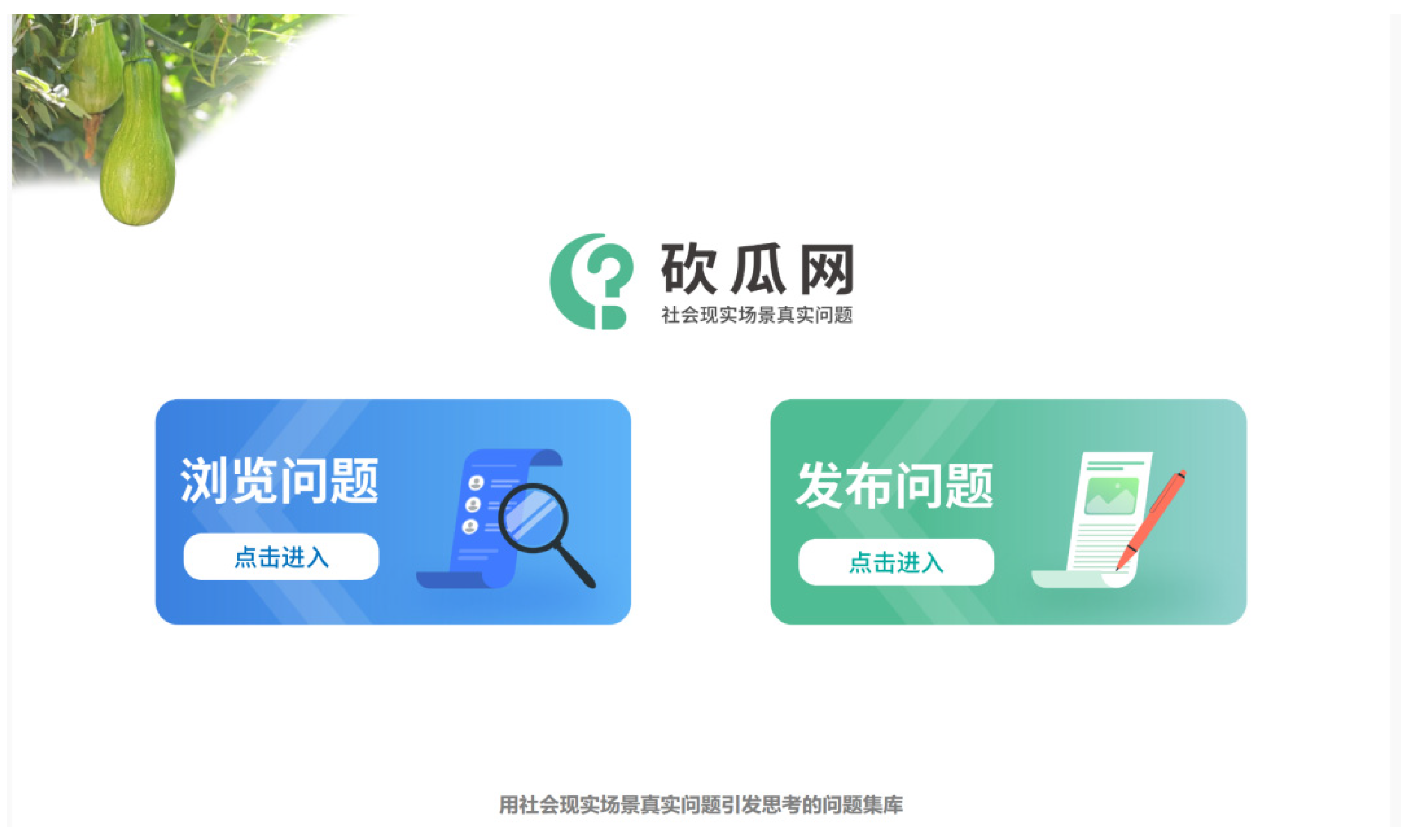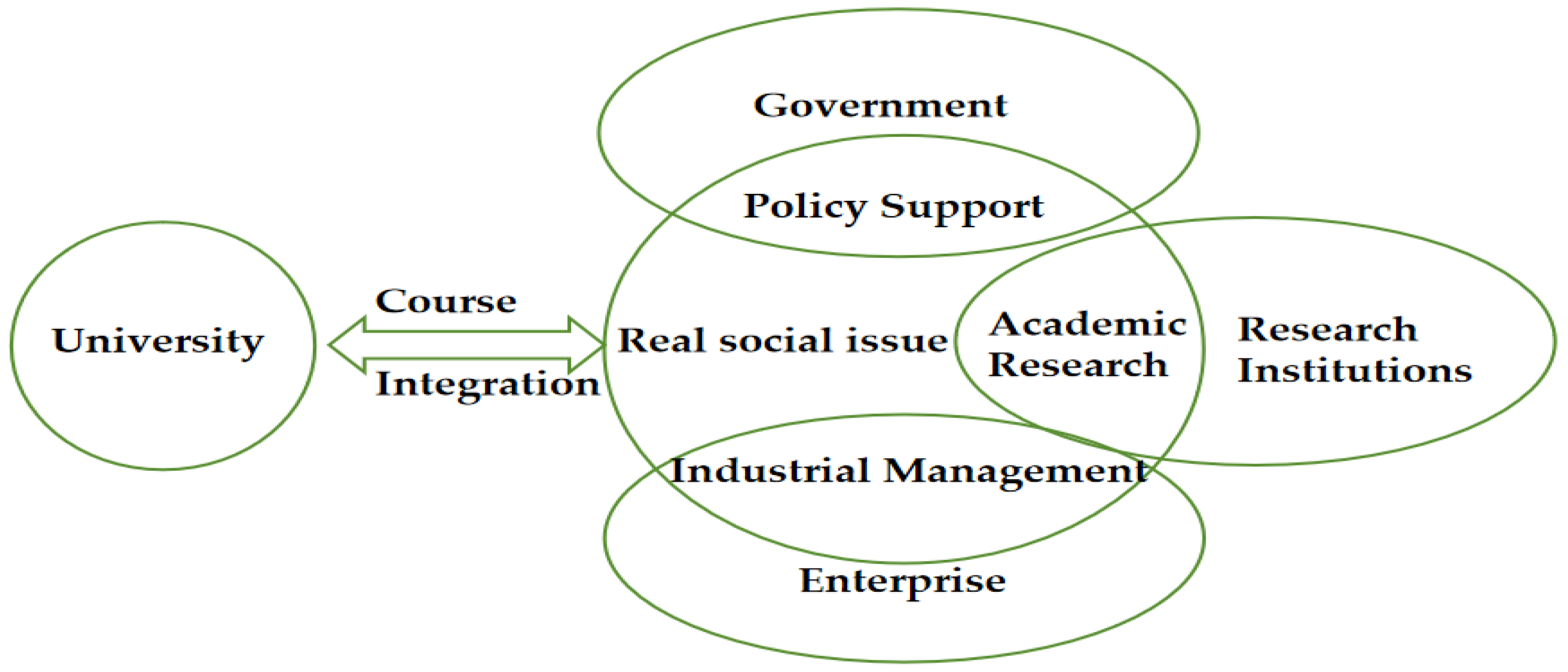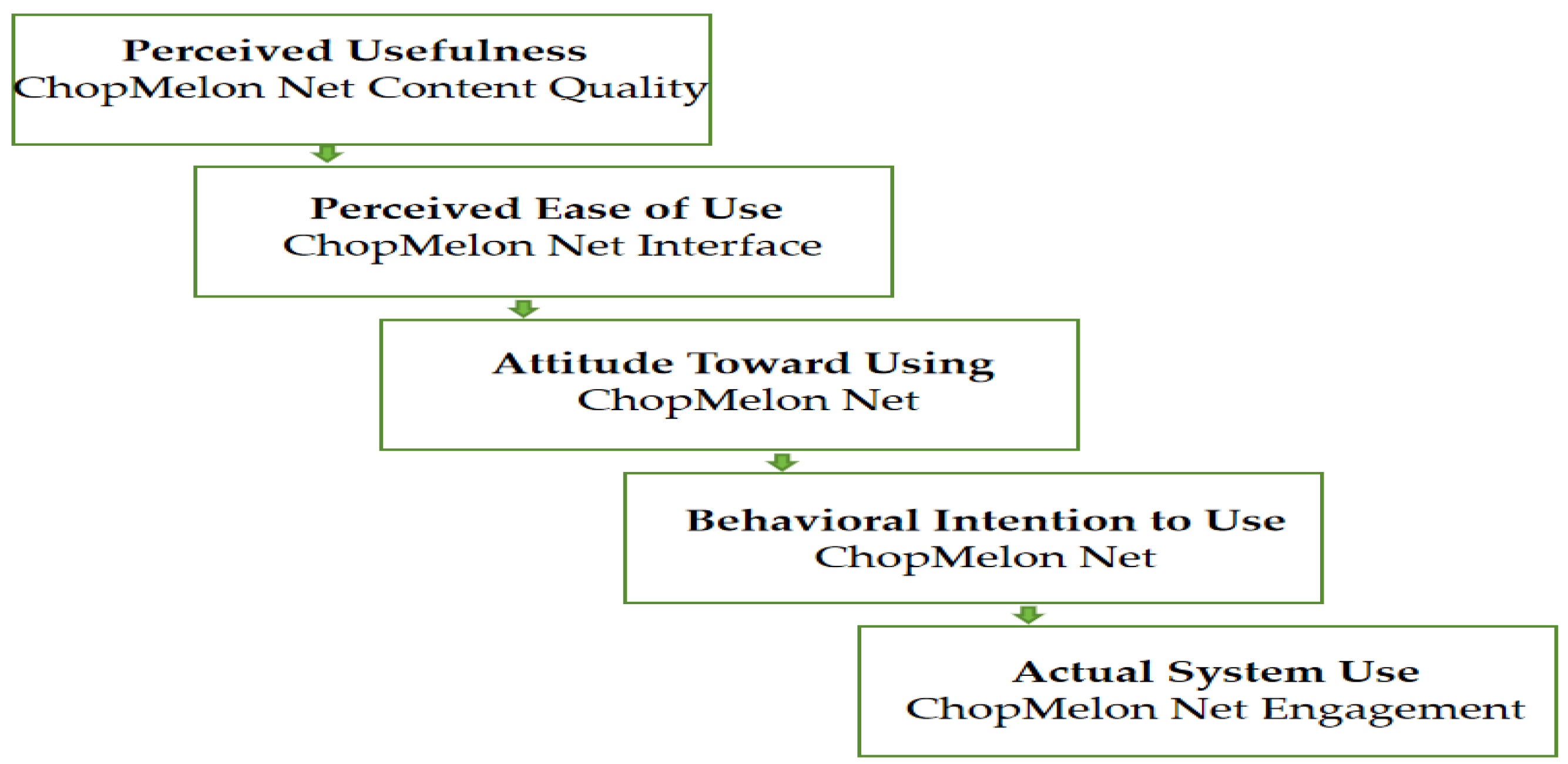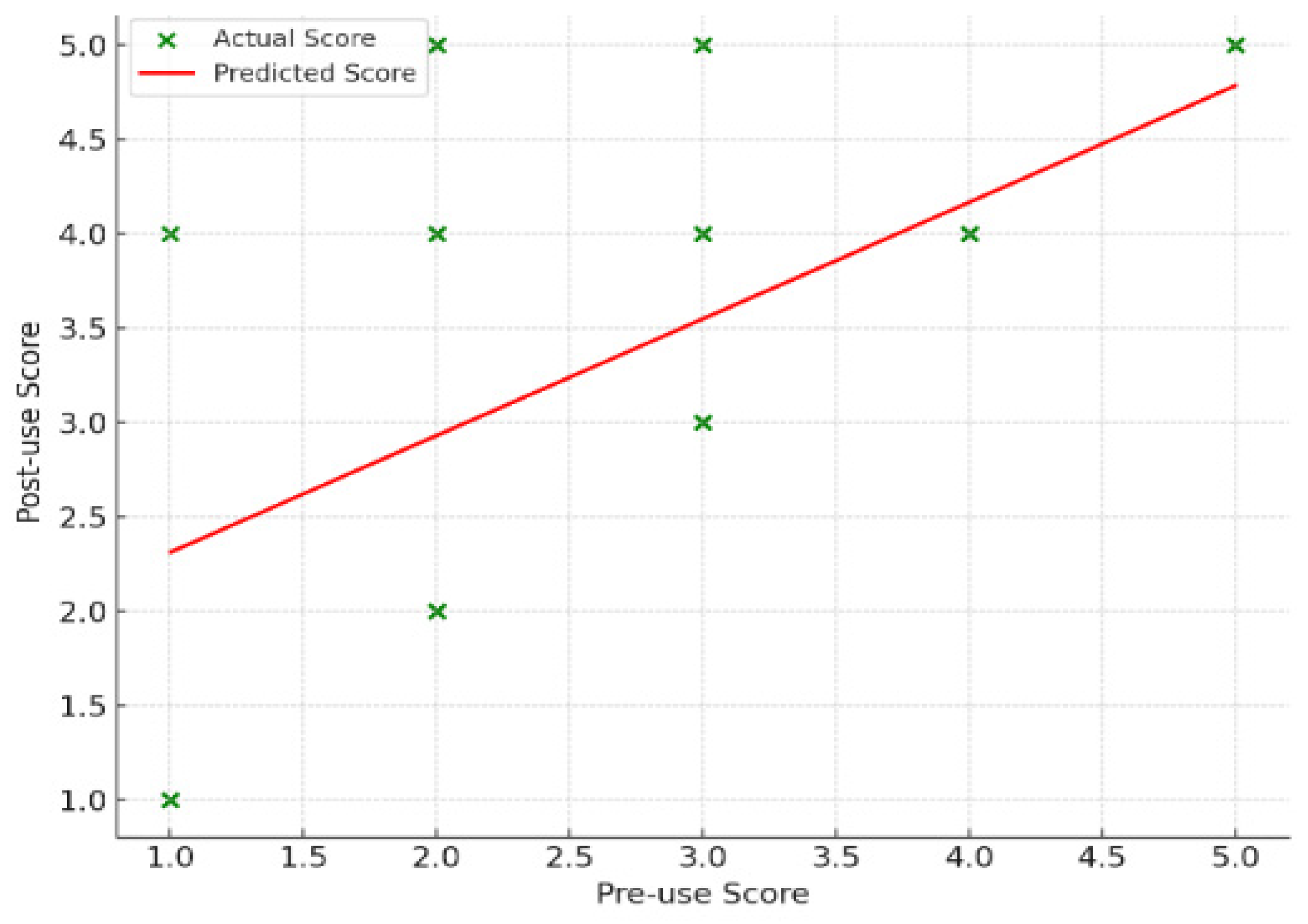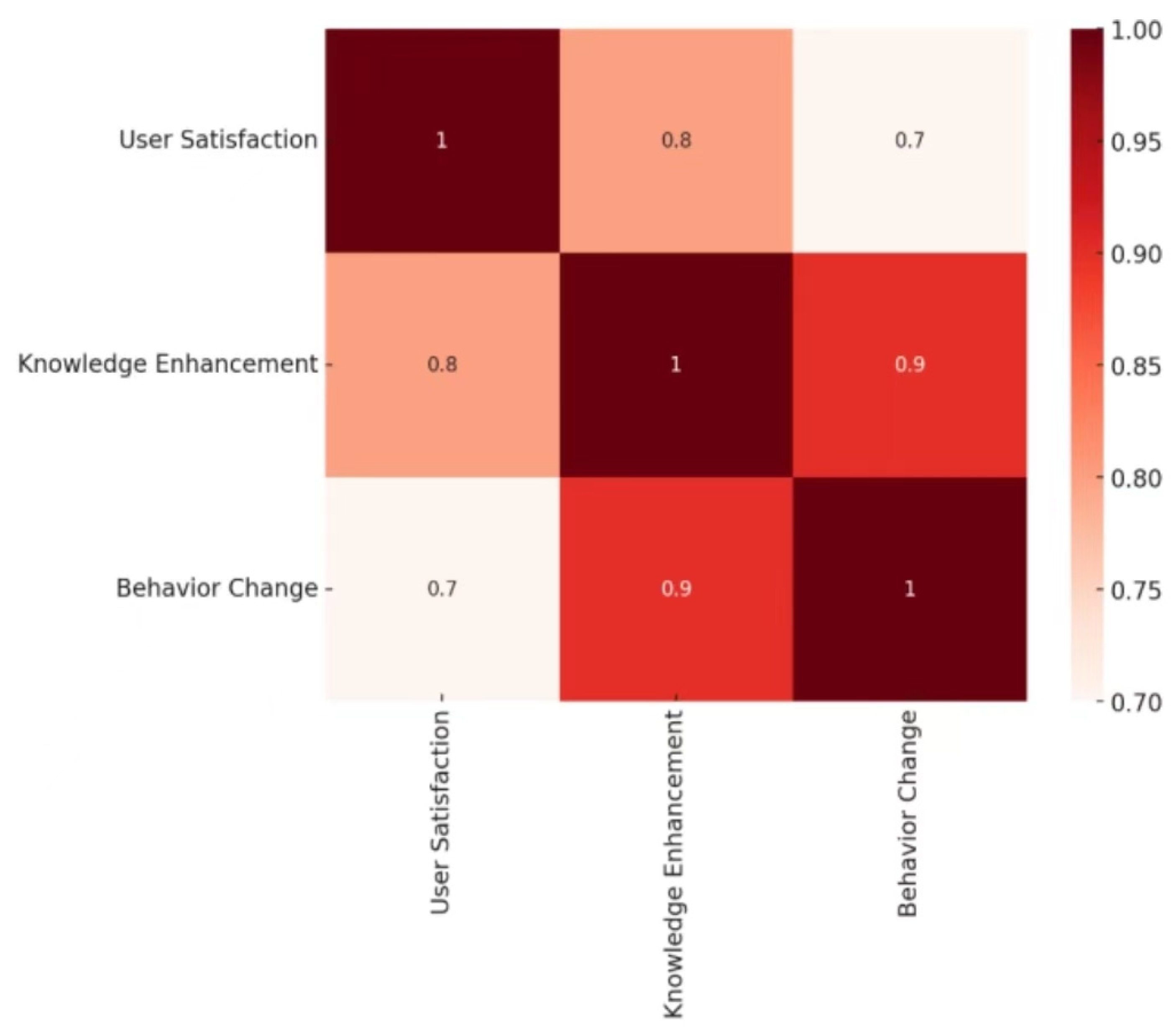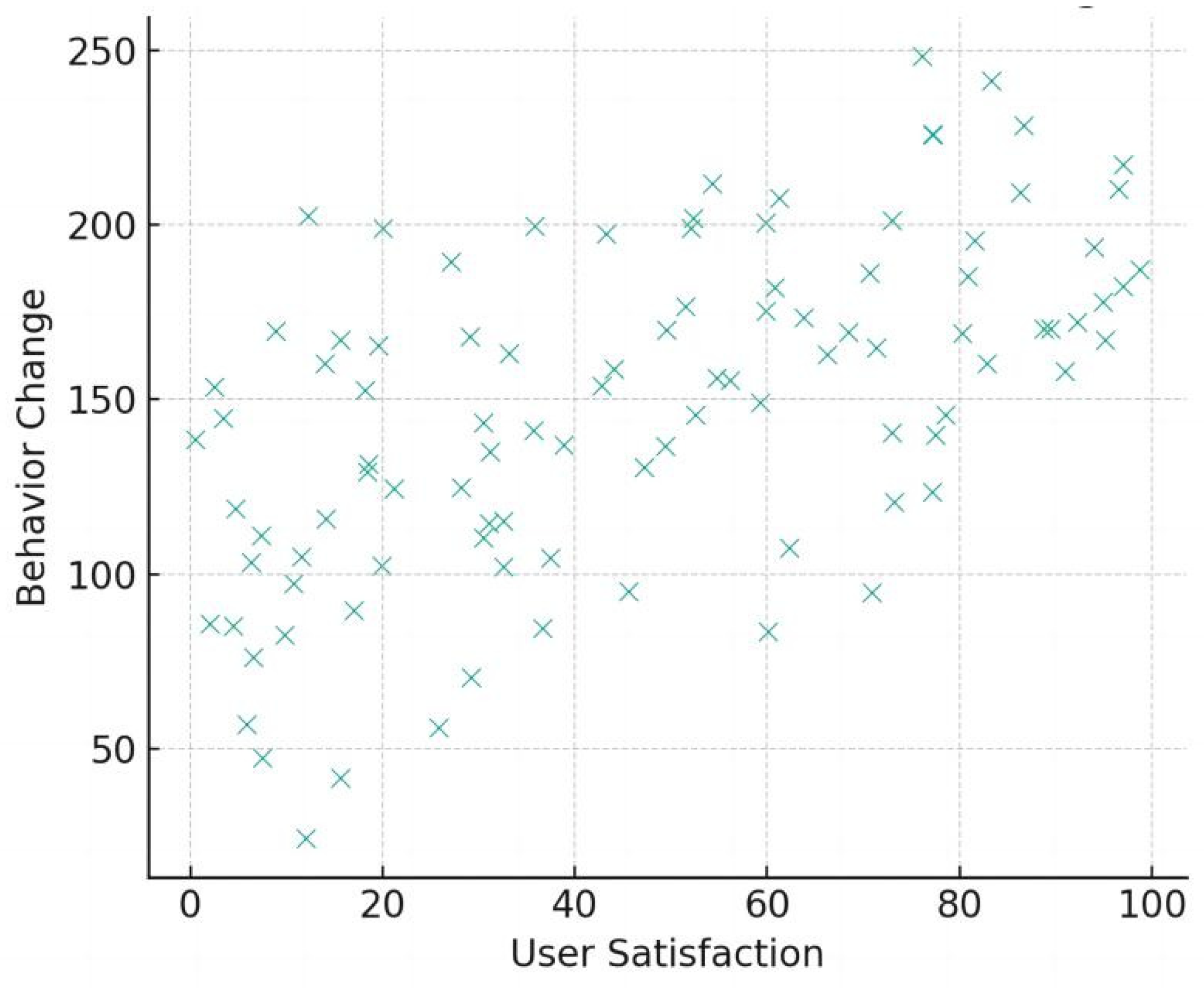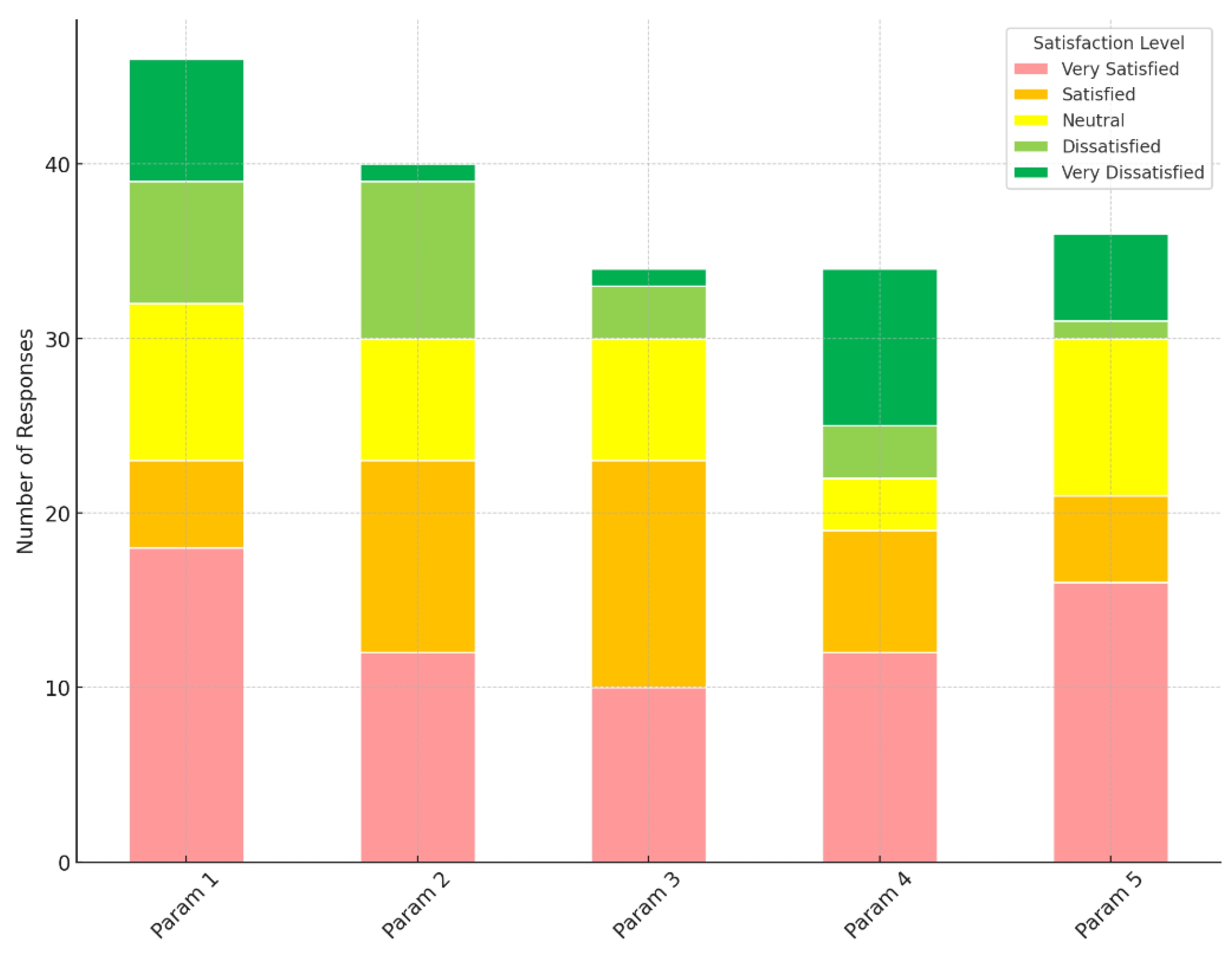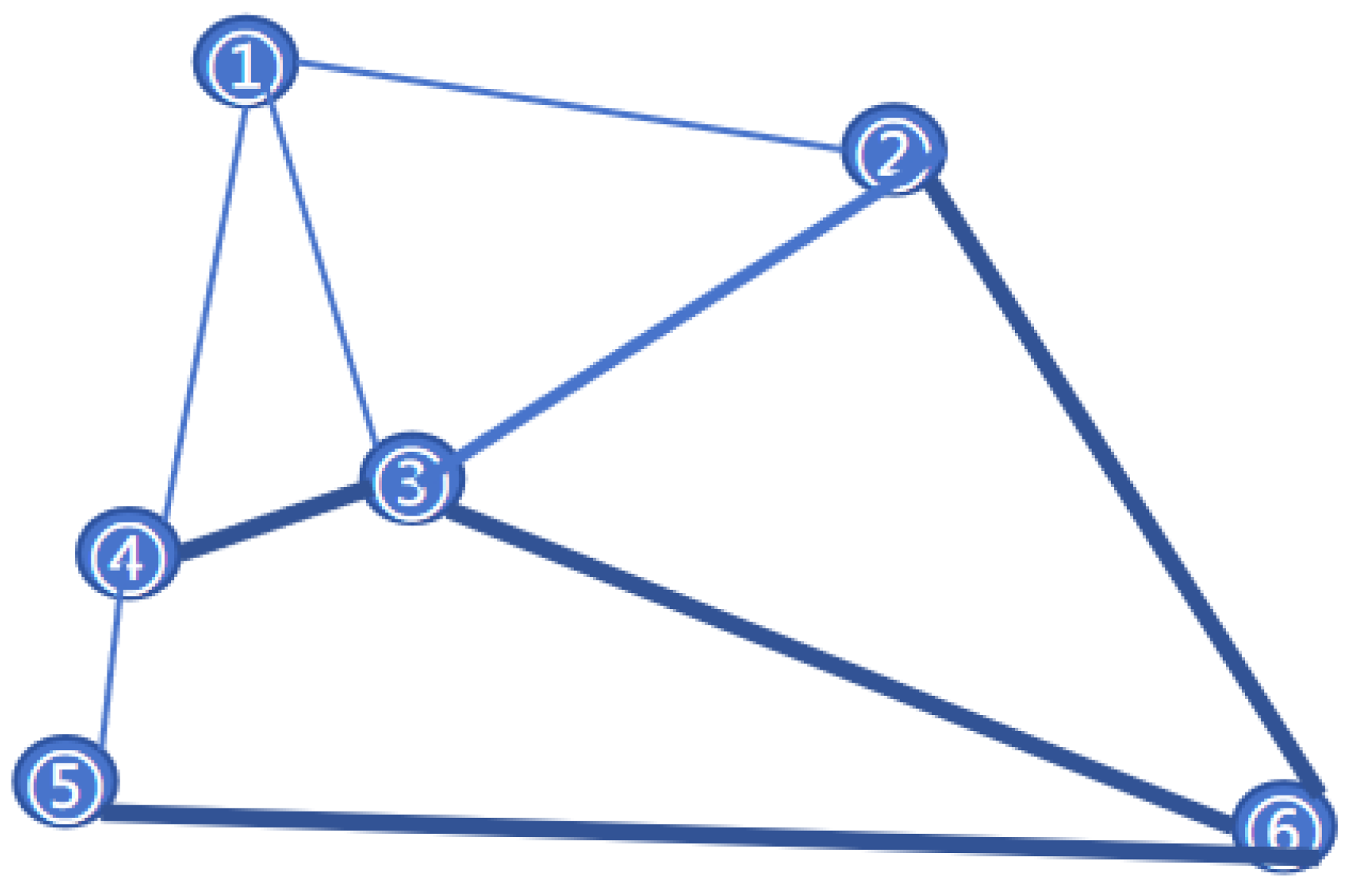3.1. Results of the Online Questionnaire One
By analyzing users’ self-assessment data on critical thinking skills before and after using ChopMelon Net, we observed significant improvements (
Table 3).
Comparative analysis: Before using ChopMelon Net, only 21% of users rated their critical thinking skills as “high” or “very high”. After 6 months of using ChopMelon Net, this percentage increased to 55%.
Creating hypotheses:
H0: There will be no change in the average score of critical thinking skills before and after using ChopMelon Net.
H1: The average score of users’ critical thinking skills increased after the use of ChopMelon Net.
The percentage difference between before and after the use of ChopMelon Net is p1 − p2 = 55% − 21% = 34% = 0.34
Calculate the standard error SE:
n1 = n2 = 200 is the sample size, yielding SE = 0.0455.
Calculate the test z: z = (p1 − p2)/SE = 7.4725.
At z = 7.4725, the p-value is very close to 0. Therefore, it can be concluded that a p-value of <0.05 indicates that there is a significant change in the percentage of users who consider themselves to be critical thinkers before and after using ChopMelon Net. It can be seen that ChopMelon Net has a significant impact on the improvement of users’ critical thinking skills.
By analyzing the self-assessment data on the improvement in users’ problem-solving skills before and after using ChopMelon Net, we observed significant improvements (
Table 4).
Comparative analysis: Before using ChopMelon Net, about 39% of users considered themselves to be “high” or “very high” in problem-solving skills. After using the platform, this percentage increased to 62%.
Same as above, the hypothesis was established and the standard error SE = 0.0486 was calculated. The test z = 4.732510 was calculated, with a p-value of <0.05 indicating that there is a significant change in the proportion of users who consider themselves to be high or very high in problem-solving ability before and after using ChopMelon Net. It can be seen that ChopMelon Net has a significant impact on users’ problem-solving abilities.
In addition, we used regression analysis to more precisely analyze the impact of ChopMelon Net on learners’ critical thinking and problem-solving skills. Through regression analyses, we found that the use of ChopMelon Net had a significant positive effect on both critical thinking skills and problem-solving skills of the learners.
Table 5 and
Figure 6 and
Figure 7 show the actual values of the two competency scores versus the values predicted through the regression, and it can be seen that the vast majority of learners made significant improvements in both skills after using ChopMelon Net. However, the explanatory power of the models (R2 = 0.260 and 0.348) suggests that despite being statistically significant, there are other factors that may influence the enhancement of these skills that are not fully captured in the current model. Therefore, future research needs to consider including more variables such as learners’ background, previous learning experiences, and personal attitudes towards learning, which may have a significant impact on learning outcomes. In addition, while the regression model in this study provided useful preliminary information, the low level of explanation prompted further optimization of the model to provide a more comprehensive understanding of the various factors that influence learner outcomes.
The statistics of the scores of the overall evaluation part of the questionnaire were used to understand the satisfaction of the users with the effectiveness of the use of the ChopMelon Net.
From
Figure 8, we can see that more than half of the users of ChopMelon Net think it is highly effective in helping to understand and solve real social problems (with a score of 80–100), while 19% of them also think that it is effective (with a score of 60–80), showing that most of the users hold a positive and favorable opinion of ChopMelon Net. However, there are also 7% of users who think it is average (with a score of 40–60) and even 6% of users who think it is low (with a score of 20–40). This shows that although most users are satisfied with the effectiveness of ChopMelon Net, there are still some users who have reservations or negative attitudes toward its effectiveness.
The suggestions for improvement made by users were categorized and analyzed. Among them, the speed of updating and the coverage of the platform’s content are the most desired improvements, accounting for 30% of the users. They believe that ChopMelon Net needs to update its content in a more timely and comprehensive manner to meet their growing learning needs. Secondly, users hope that the platform can add more interactive and social features, accounting for 25% of the total. They believe this can enhance communication and learning among users and improve learning outcomes. In addition, the platform’s user interface and user experience, technical support, and customer service are also the focus of users’ attention.
3.2. Results of the Online Questionnaire Two
Based on the feedback collected in the online questionnaire two, we use Pearson’s correlation coefficient to analyze the correlation between user satisfaction, behavior change, and knowledge enhancement.
Each cell shows the correlation coefficient between two variables, where 1 indicates a perfect positive correlation and 0 indicates no correlation. As we can see from
Figure 9, the correlation coefficients between all variables are above 0.7, which indicates that there is a strong positive correlation between these variables in these data. Such results imply that user satisfaction, knowledge growth, and behavioral change are interrelated in the ChopMelon Net environment.
The three scatter plots show the relationship between “knowledge enhancement” and “behavioral change”, “user satisfaction” and “knowledge enhancement”, and “user satisfaction” and “behavioral change”, respectively, as can be seen from the scatter plots.
Figure 10 shows a significant positive correlation between “knowledge enhancement” and “behavioral change”, which reveals a key finding that as users’ knowledge grows, their behavioral change becomes more pronounced. This phenomenon clearly indicates that ChopMelon Net not only effectively contributes to the growth of users’ knowledge, but also leads to a positive behavioral change. This transformation from knowledge to action demonstrates that ChopMelon Net motivates users to apply what they have learned to their daily lives.
Figure 11 reveals a positive correlation between “user satisfaction” and “knowledge enhancement”, suggesting that when users are more satisfied with the platform, their growth in sustainable knowledge is also more significant. This finding suggests that ChopMelon Net has been successful in creating and distributing educational content that meets the learning needs and expectations of its users. This positive feedback loop not only strengthens users’ trust and reliance on the platform, but also plays a key role in enhancing their knowledge. High levels of user satisfaction often reflect the ease of use, richness of content, and attractiveness of the platform, and these elements combine to enhance the user’s learning experience, making the absorption and understanding of knowledge more effective.
Figure 12 shows the positive correlation between “user satisfaction” and “behavioral change”, suggesting that a high level of user satisfaction with the platform may be closely related to changes in their sustainable behavior. This finding suggests that ChopMelon Net has not only won praise from users for providing high-quality educational content, but has also succeeded in encouraging users to apply what they have learned in real-life situations, leading to real behavioral change. This positive change underlines a key point, the true value of education lies not only in the acquisition of knowledge, but also in the ability to translate that knowledge into concrete action. By increasing user satisfaction, ChopMelon Net effectively bridges the gap between knowledge and action, proving the remarkable effectiveness of its platform in promoting sustainability education and its practice, and laying a solid foundation for achieving broader social and environmental goals.
3.3. Results of the Semi-Structured Interviews
Based on the feedback collected from the interviews, we broadly categorized the themes into five parameters: Parameter 1 “improved critical thinking skills”; parameter 2 “user satisfaction”; parameter 3 “increased knowledge”; parameter 4 “behavioral change”; and parameter 5 “improved problem-solving skills”. We had 20 interviewers, and each user provided feedback on five different parameters. Since each user responded to each parameter, the total number of responses is 100 (20 users × 5 parameters). (Note: It is important to note that the total number of responses to the data, 190, exceeded the expected 100 (20 users × 5 parameters) due to the fact that the interviews encouraged users to provide multiple levels of feedback on each parameter, i.e., rather than just giving a single satisfaction rating for each parameter, users provided feedback based on different dimensions of the experience (e.g., quality of content, interactive experience, application practices), and therefore multiple ratings were provided.)
We present these responses using stacked bar charts (
Figure 13).
Improved critical thinking skills received a high number of very satisfied ratings (18), but also a relatively high number of unsatisfied (7) and very unsatisfied ratings (7). This suggests that while ChopMelon Net performed well for the majority of users in terms of improving critical thinking skills, there was a certain percentage of users who did not feel the expected improvement, suggesting that the developers need to further review the course content and teaching methods in order to better meet the learning needs of all users.
Overall user satisfaction ratings of ChopMelon Net are relatively balanced, with very satisfied (12) and satisfied (11) ratings dominating. The high satisfaction ratings indicate that users are generally satisfied with the interface, content, and functionality of ChopMelon Net. The low number of dissatisfied (9) and very dissatisfied (1) ratings point to specific areas of improvement, such as improving interactivity or enhancing the personalized learning experience.
In terms of Increased knowledge, user feedback shows a more even distribution of satisfaction, with a preponderance of very satisfied (10) and satisfied (13) ratings. This result suggests that ChopMelon Net has performed well in enhancing users’ knowledge related to sustainable development, especially in promoting their ability to understand and respond to real social issues. However, there is still room to further enhance user satisfaction by adapting and enriching the pedagogical content.
Behavioral change received a relatively high number of very unsatisfactory ratings (9), which may reflect the challenges that users face in applying what they have learned to practical behavior. Although ChopMelon Net is designed to facilitate the practical application of knowledge, users may not be able to adequately demonstrate learned knowledge and skills in practice. This suggests the need to further explore mechanisms to support changes in user behavior, such as providing more practical guidance and case studies.
Improvement in problem-solving skills received relatively consistent ratings of very satisfied (16) and satisfied (5), indicating that users generally found ChopMelon Net to be effective in improving problem-solving skills. The high level of user satisfaction reflects ChopMelon Net’s success in designing and implementing problem-solving-related courses and activities.
Taken together, ChopMelon Net has demonstrated its potential and effectiveness in enhancing users’ critical thinking and problem-solving skills, strengthening knowledge related to sustainable development, and promoting behavioral change. However, it is also evident from the feedback reflected in the different dimensions of user satisfaction that there is room for further optimization and improvement, especially in ensuring that all users experience full learning effectiveness and behavioral change. ChopMelon Net needs to focus in the future on enhancing the personalized and practical nature of the content, as well as on improving the user-friendliness of the technical support and the user interface, so as to improve overall user satisfaction and learning outcomes.
In addition, we derived six sub-themes from the above five thematic parameters, namely, interactive experience and user engagement ①, depth and breadth of knowledge ②, technology acceptance and usage experience ③, continuous learning and self-development ④, community interaction and learning motivation ⑤, and practical application and behavioral change ⑥.
As can be seen in
Figure 14, experience and user engagement ① is the most prominent sub-theme and is the one that has a direct link to all the other sub-themes. This demonstrates that user experience and engagement are the basis for the other learning outcomes, and if users are not engaged, the other learning outcomes are difficult to achieve. ChopMelon Net enhances user learning experience and engagement by providing interactive and practical questions to engage users, i.e., depth and breadth of knowledge ②. As an educational platform, ChopMelon Net provides content that not only covers multiple domains, but also digs deeper into the knowledge of each domain. User feedback suggests that they are able to deepen their understanding of sustainability topics through ChopMelon Net, which is crucial for solving problems in the real world. Technology acceptance and experience of use ③ concerns how users evaluate the ease of use of the platform and the technology it provides. According to feedback, users’ technology acceptance largely determines whether they continue to use ChopMelon Net. The platform needs to ensure that the user interface is user-friendly, and the content is of a high quality to promote long-term user engagement. Continuous learning and self-development ④ considers how users not only gain knowledge on ChopMelon Net, but also how they can achieve self-improvement through continuous learning. The continuous self-development path demonstrates the long-term value of education, especially in terms of critical thinking and problem-solving skills. Community interaction and learning motivation ⑤ shows the motivation that users gain through interaction with others. Community interaction motivates learners to continue exploring and provides support during the learning process, and this community power has a significant impact on learner motivation. Practical application and behavioral change ⑥ is a reflection of how users translate what they have learned into practical action. This demonstrates not only the practicality of the educational content, but also the effectiveness of ChopMelon Net in facilitating user behavioral change, which is particularly crucial for ESD.
